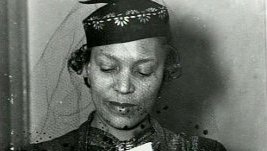Teachers' Domain - Digital Media for the Classroom and Professional Development
User: Preview

Source: A Walk Through Harlem


Funding for the VITAL/Ready to Teach collection was secured through the United States Department of Education under the Ready to Teach Program.
This video segment from A Walk Through Harlem takes a look at the Harlem Renaissance, a large social and cultural movement of the early 1900s -1930s stemming from the “Great Migration" of African Americans from the rural South to cities of the urban North of the United States. They moved to escape the "Jim Crow" segregation, violence and oppressive nature of the South. In New York City, they found their voices in a politically, socially and culturally vibrant Harlem. Harlem spawned writers and poets like Langston Hughes, Zora Neale Hurston, Countee Cullen, Claude McKay, and Alain Locke, whose writing encouraged African Americans to take on an independent, enlightened approach to education, culture and politics.
American history, African American history, literature, Harlem Renaissance, poets
The following Frame, Focus and Follow-up suggestions are best suited for middle school students using this video in an English language arts or social studies lesson. Be sure to modify the questions to meet your students' instructional needs.
What is Frame, Focus and Follow-up?
Frame (ELA) What is symbolism? In the 1920s African Americans made the physical and culturally symbolic move from the South to the North. What did the "Great Migration" symbolize? What is meant by “culturally symbolic”?
Focus (ELA) What did the writings and new ideas of the Harlem Renaissance symbolize for African Americans? While watching the segment, decide how the migration was symbolic.
Follow Up (ELA) Discuss the concept of the “New Negro" and the writers of the Harlem Renaissance period. What did this change in attitude and direction symbolize for African Americans? Can you think of a social movement that has symbolical importance for you? Think about the important people, events or developments that occurred to shape this movement and describe it in a short paragraph.
Frame (SS) Various African American artists, writers and thinkers inspired other African Americans during the Harlem Renaissance through their art, writing, poetry, and ideas. Who were some of the writers, poets and thinkers of the Harlem Renaissance? What are some ways these writers and poets influenced or shaped people's ideas during this period?
Focus (SS) While watching the video segment, think about how you would define a large social movement.
Follow Up (SS) What was the social impact the writers and thinkers mentioned in the segment had on the Harlem Rennaissance? Research and learn more about the writers and thinkers of that time to make this determination.
DAVID HARTMAN: This mosaic we’re standing on- what is it?
BARRY LEWIS: This mosaic is a memorial to Langston Hughes and Arturo Schomburg. The idea for the mural was taken from the first poem that Langston Hughes had published: “The Negro Speaks of Rivers”.
DAVID HARTMAN: Describe the Harlem Renaissance. What does that really mean?
PROFESSOR KATE RUSHIN: Well, the Harlem Renaissance is really talking about a very large social movement that was fueled by many different factors. Including the great migration of African Americans from the rural south Jim Crow and segregation to the north, looking for better opportunities and relief from some of the violence and the oppressive share- cropping system. So it was a shift from rural south to urban north.
DAVID HARTMAN: Who were the writers and the poets during this period?
PROFESSOR KATE RUSHIN: We’ve already mentioned Langston Hughes as one of the primary movers, Allan Locke author of the essay “A New Negro” was certainly instrumental and inspiring to people, especially young people to leave behind the old subservient attitudes and to take a new pride and to make out into areas of education and art and the political world. Other important people in the period were County Collin who’s considered a primary poet of the period also Claude Mc Kay, Zora Neal Hurston who actually at one point collaborated with Langston Hughes.
 Loading Standards
Loading Standards